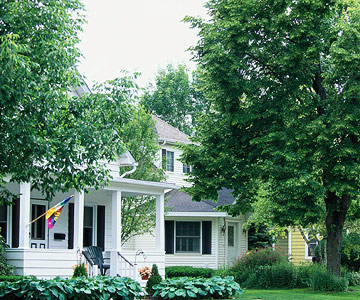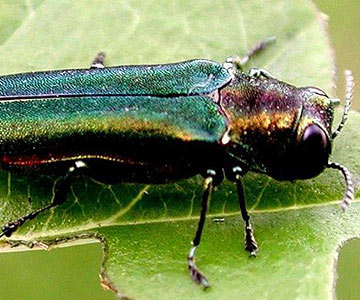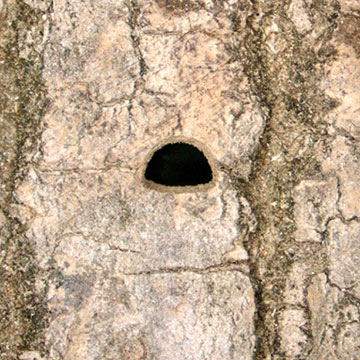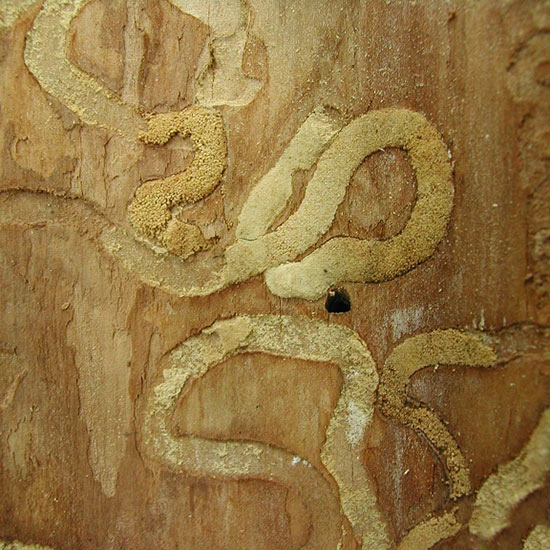





 Fast-growing ash are common residential and community park trees.
Fast-growing ash are common residential and community park trees.
Once a common and easy-to-grow tree in the eastern Midwest, ash trees are now greatly reduced in Michigan, Ohio, Indiana and surrounding states. Decades old specimens as well as young saplings have fallen to an invasive pest commonly called emerald ash borer or E.A.B.
This destructive beetle hitchhiked from Asia where it has long infested ash trees. It slowly gained foothold in North America and is now moving across the central United States infesting all types of ash trees—green, white, blue. All members of the Fraxinus species are susceptible to attack.
E.A.B. is a very small, metallic green beetle. The adult beetles feed on ash leaflets while the immature larvae feed underneath the bark on the living tissue inside the tree. As the larvae feed, they cut of the tree's supply of nutrients, minerals, and water. This causes a slow decline that results in tree death in two to four years after the tree is infested. There are few effective controls to stop the beetles' destruction.
continue reading below Emerald ash borer. Photo by Leah Bauer, USDA Forest Service Northern Research Station, Bugwood.org
Emerald ash borer. Photo by Leah Bauer, USDA Forest Service Northern Research Station, Bugwood.org
Emerald ash borers are ½-inch-long, bright metallic green insects that are rarely seen. They feed on leaves and are active in the summer months. The white worm-like larvae feed under the bark of an ash tree, boring s-shaped tunnels as they move through the tree.
 E.A.B. creates these d-shape holes in bark when it exits a tree. Photo provided by Pennsylvania Department of Conservation and Natural Resources—Forestry Archive, Bugwood.org
E.A.B. creates these d-shape holes in bark when it exits a tree. Photo provided by Pennsylvania Department of Conservation and Natural Resources—Forestry Archive, Bugwood.org
Often ash trees exhibit signs of infestation before the pests themselves are noticed. Canopy dieback is a sign of infestation. Dieback begins in the top one-third of the canopy and progresses during subsequent growing seasons until the canopy is bare. The tree might also produce vigorous shoots at ground level and the new leaves are usually larger than normal.
Close inspection of the bark might reveal unique "D" shape exit holes. The larvae create these holes when they emerge from the bark. Peal away a bit of the bark and you might see serpentine feeding galleries.
Increased woodpecker activity is also a potential sign of infestation. The woodpecker is searching out beetle larvae.
When adding new trees to your landscape, do not palnt ash. Even if E.A.B. is not prevalent in your area, entomlogist predict that it will slowly move across the United Steas., destroying most ash trees in its path. Instead of an ash tree, choose a speices that is native to your area. A local garden center or your state Extension personnel can provide recommendations.
The best weapon asgainst E.A.B. is a healthy tree. Follow these tips for promoting healthy trees.
 Serpentine feeding galleries like these are a sign that E.A.B. has already infested your tree. Treatment is not recommended. Photo by Pennsylvania Department of Conservation and Natural Resources—Forestry Archive, Bugwood.org.
Serpentine feeding galleries like these are a sign that E.A.B. has already infested your tree. Treatment is not recommended. Photo by Pennsylvania Department of Conservation and Natural Resources—Forestry Archive, Bugwood.org.
There is no sure-fire method of protecting an ash tree from infestation, nor is there a guaranteed cure for infested trees. There are several treatments in the market place with varying success rates. Here are a few things to know before you invest in a chemical control strategy.
Copyright © www.100flowers.win Botanic Garden All Rights Reserved